
George Dewey Cukor was an American film director and producer. He mainly concentrated on comedies and literary adaptations. His career flourished at RKO when David O. Selznick, the studio's Head of Production, assigned Cukor to direct several of RKO's major films, including What Price Hollywood? (1932), A Bill of Divorcement (1932), Our Betters (1933), and Little Women (1933). When Selznick moved to Metro-Goldwyn-Mayer in 1933, Cukor followed and directed Dinner at Eight (1933) and David Copperfield (1935) for Selznick, and Romeo and Juliet (1936) and Camille (1936) for Irving Thalberg.

Marilyn Monroe was an American actress and model. Known for playing comic "blonde bombshell" characters, she became one of the most popular sex symbols of the 1950s and early 1960s, as well as an emblem of the era's sexual revolution. She was a top-billed actress for a decade, and her films grossed $200 million by the time of her death in 1962. Long after her death, Monroe remains a pop culture icon. In 1999, the American Film Institute ranked her as the sixth-greatest female screen legend from the Golden Age of Hollywood.

Cyd Charisse was an American dancer and actress.

The Misfits is a 1961 American Contemporary Western film written by Arthur Miller, directed by John Huston, and starring Clark Gable, Marilyn Monroe, and Montgomery Clift. The supporting cast includes Thelma Ritter and Eli Wallach. Adapted by Miller from his own short story of the same name published in Esquire in October 1957, The Misfits was the last completed film for both Clark Gable and Marilyn Monroe. For Gable, the film was posthumously released, while Monroe died in August 1962 after its release. The plot centers on Roslyn Tabor (Monroe), a newly divorced woman from Reno, and her relationships with friendly landlady Isabelle Steers, an old-school cowboy Gaylord Langland (Gable), his tow-truck driving and plane-flying best friend (Wallach), and their rodeo-riding, bronc-busting friend (Clift).

Enoch Arden is a narrative poem by Alfred, Lord Tennyson, published in 1864 during his tenure as British poet laureate. The story on which it was based was provided to Tennyson by Thomas Woolner. The poem lends its name to a principle in law that after being missing for a certain number of years a person may be declared dead for purposes of remarriage and inheritance of their survivors.
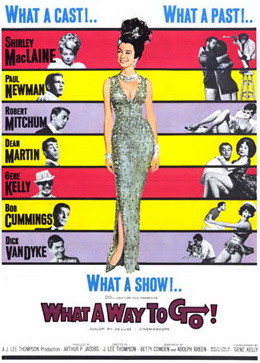
What a Way to Go! is a 1964 American black comedy film directed by J. Lee Thompson and starring Shirley MacLaine, Paul Newman, Robert Mitchum, Dean Martin, Gene Kelly, Bob Cummings and Dick Van Dyke.

Sheree North was an American actress, dancer, and singer, known for being one of 20th Century-Fox's intended successors to Marilyn Monroe.
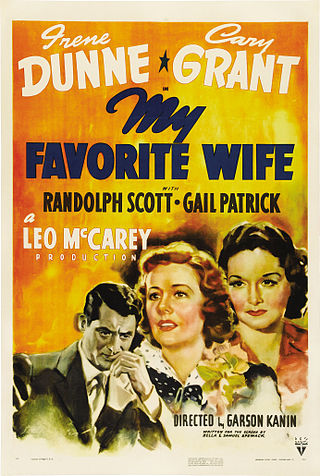
My Favorite Wife, released in the United Kingdom as My Favourite Wife, is a 1940 screwball comedy produced by Leo McCarey and directed by Garson Kanin.
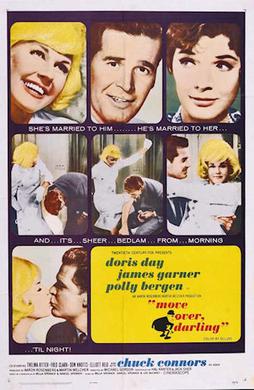
Move Over, Darling is a 1963 American comedy film starring Doris Day, James Garner, and Polly Bergen and directed by Michael Gordon filmed in DeLuxe Color and CinemaScope released by 20th Century Fox.

Jean Louis was a French-American costume designer. He won an Academy Award for The Solid Gold Cadillac (1956).

"Happy Birthday, Mr. President" is a song sung by actress and singer Marilyn Monroe on May 19, 1962, for President John F. Kennedy at a gala held at Madison Square Garden for his 45th birthday, 10 days before the actual date. The event was co-hosted by Arthur B. Krim and Anna M. Rosenberg, who sat next to the President during the star-studded event.

On the evening of August 4, 1962, American actress Marilyn Monroe died at age 36 of a barbiturate overdose inside her home at 12305 Fifth Helena Drive in Brentwood, Los Angeles, California. Her body was discovered before dawn the following morning, on August 5. Monroe had been one of the most popular Hollywood stars during the 1950s and early 1960s, and was a top-billed actress for the preceding decade. Her films had grossed $200 million by the time of her death.
Leon Shamroy, A.S.C. was an American film cinematographer known for his work in 20th Century Fox motion pictures shot in Technicolor. He and Charles Lang share the record for most Oscar nominations for Cinematography. During his half-century career, he gained 18 nominations with 4 wins, sharing the record for wins with Joseph Ruttenberg.

Let's Make Love is a 1960 American musical comedy film made by 20th Century Fox in DeLuxe Color and CinemaScope. Directed by George Cukor and produced by Jerry Wald from a screenplay by Norman Krasna, Hal Kanter, and Arthur Miller, the film stars Marilyn Monroe, Yves Montand, and Tony Randall. It would be Monroe's last musical film performance.
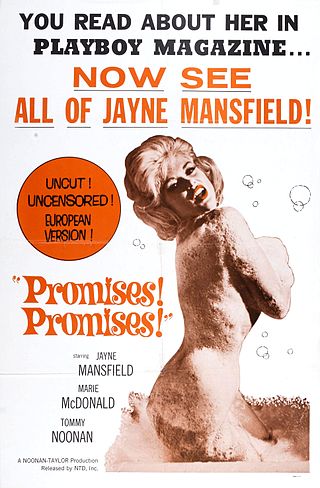
Promises! Promises! is a 1963 American sex comedy film directed by King Donovan and starring Tommy Noonan and Jayne Mansfield. Released at the end of the Production Code era and before the MPAA film rating system became effective in 1968, it was the first Hollywood film of the sound era to feature nudity by a mainstream star (Mansfield).

Marilyn Monroe was an American actress who appeared in 29 films between 1946 and 1961. After a brief career in modeling she signed short-term film contracts, first with 20th Century Fox, then Columbia Pictures, and appeared in minor roles for the first few years of her career. In 1950, she made minor appearances in two critically acclaimed films, The Asphalt Jungle and All About Eve. The parts in the two films were against many of the roles into which she was typecast, that of the dumb blonde. Margot A. Henriksen, her biographer with the American National Biography, considers the typecast "an unfair stereotype that bothered her throughout her career".
Marilyn is a 1963 documentary film based on the life of the 1950s to early 1960's actress and sex symbol Marilyn Monroe. The film, directed by Harold Medford, was released by 20th Century Fox, and was narrated by Rock Hudson.
Peter Levathes was an American film and advertising executive, best known for briefly running 20th Century Fox.
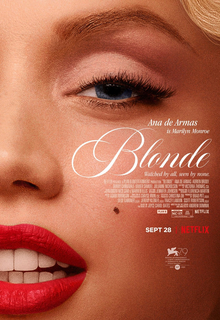
Blonde is a 2022 American biographical psychological drama film written and directed by Andrew Dominik, based on the 2000 novel of the same name by Joyce Carol Oates. The film is a fictionalized take on the life and career of American actress Marilyn Monroe, played by Ana de Armas. The cast also includes Adrien Brody, Bobby Cannavale, Xavier Samuel, and Julianne Nicholson.

The Mystery of Marilyn Monroe: The Unheard Tapes is a 2022 American documentary film directed by Emma Cooper for Netflix. It is centered on the life and untimely death of American actress and cultural icon Marilyn Monroe and is told through archival footage and unseen interviews with friends of the star. The film was released on April 27, 2022.


















